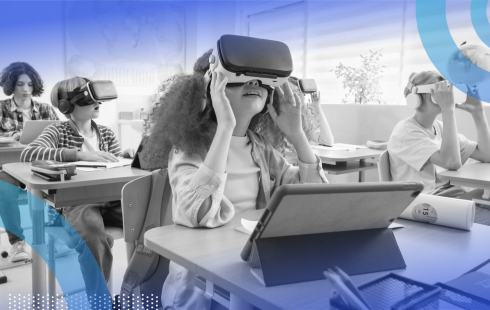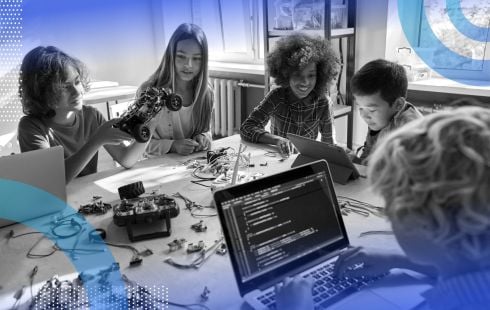25 Edtech Companies Changing the Way We Learn

Edtech, or education technology, is the combination of IT tools and educational practices aimed at facilitating and enhancing learning.

Edtech, or education technology, is the practice of introducing information and communication technology tools into the classroom to create more engaging, inclusive and individualized learning experiences.
Today’s classrooms have moved beyond the clunky desktop computers that were once the norm and are now tech-infused with tablets, interactive online courses and even robots that can take notes and record lectures for absent students.
The influx of edtech tools are changing classrooms in a variety of ways. For instance, edtech robots, virtual reality lessons and gamified classroom activities make it easier for students to stay engaged through fun forms of learning. And edtech IoT devices are hailed for their ability to create digital classrooms for students, whether they’re physically in school, on the bus or at home. Even machine learning and blockchain tools are assisting teachers with grading tests and holding students accountable for homework.
The potential for scalable individualized learning has played an important role in the edtech industry’s ascendance. The way we learn, how we interact with classmates and teachers, and our overall enthusiasm for the same subjects is not a one-size-fits-all situation. Everyone learns at their own pace and in their own style. Edtech tools make it easier for teachers to create individualized lesson plans and learning experiences that foster a sense of inclusivity and boost the learning capabilities of all students, no matter their age or learning abilities.
And it looks like technology in the classroom is here to stay. In a 2018 study, 86 percent of eighth-grade teachers agreed that using technology to teach students is important. And 75 percent of the study’s teachers said technology use improved the academic performance of students. For that reason, many would argue it’s vital to understand the benefits edtech brings in the form of increased communication, collaboration and overall quality of education.

An influx of technology is opening up new avenues of learning for students of all ages, while also promoting collaboration and inclusivity in the classroom. Here are five major ways edtech is directly impacting the way students learn.
Cloud-enabled tools and tablets are fostering collaboration in the classroom. Tablets loaded with learning games and online lessons give children the tools to solve problems together. Meanwhile, cloud-based apps let students upload their homework and digitally converse with one another about their thought processes and for any help they may need.
IoT devices are making it easier for students to have full access to the classroom in a digital environment. Whether they’re at school, on the bus or at home, connected devices are giving students Wi-Fi and cloud access to complete work at their own pace — and on their own schedules — without being hampered by the restriction of needing to be present in a physical classroom.
Various apps also help students and teachers stay in communication in case students have questions or need to alert teachers to an emergency.
Edtech tools are flipping the traditional notion of classrooms and education. Traditionally, students have to listen to lectures or read in class then work on projects and homework at home. With video lectures and learning apps, students can now watch lessons at home at their own pace, using class time to collaboratively work on projects as a group. This type of learning style helps foster self-learning, creativity and a sense of collaboration among students.
Edtech opens up opportunities for educators to craft personalized learning plans for each of their students. This approach aims to customize learning based on a student’s strengths, skills and interests.
Video content tools help students learn at their own pace and because students can pause and rewind lectures, these videos can help students fully grasp lessons. With analytics, teachers can see which students had trouble with certain lessons and offer further help on the subject.
Instead of relying on stress-inducing testing to measure academic success, educators are now turning to apps that consistently measure overall aptitude. Constant measurements display learning trends that teachers can use to craft specialized learning plans based on each student’s strengths and weaknesses or, more importantly, find negative trends that can be proactively thwarted with intervention.
Do you remember sitting in class, half-listening, half-day dreaming? Now, with a seemingly infinite number of gadgets and outside influences vying for a student’s attention, it’s imperative to craft lesson plans that are both gripping and educational. Edtech proponents say technology is the answer. Some of the more innovative examples of students using tech to boost classroom participation include interacting with other classrooms around the world via video, having students submit homework assignments as videos or podcasts and even gamifying problem-solving.
Students aren’t the only group benefitting from edtech. Teachers are seeing educational tech as a means to develop efficient learning practices and save time in the classroom. Here are four ways edtech is helping teachers get back to doing what they do — teaching.
Artificially intelligent edtech tools are making grading a breeze. These apps use machine learning to analyze and assess answers based on the specifications of the assignment. Using these tools, especially for objective assignments like true/false or fill-in-the-blank assessments, frees up hours that teachers usually spend grading assignments. Extra free time for teachers provides more flexibility for less prep and one-on-one time with both struggling and gifted students.
Let’s face it, trying to get a large group of kids to do anything can be challenging. Educational technology has the potential to make everything — from the way teachers communicate with their students to how students behave — a little easier. There are now apps that help send parents and students reminders about projects or homework assignments, as well as tools that allow students to self-monitor classroom noise levels. The addition of management tools in the classroom brings forth a less-chaotic, more collaborative environment.
Printing budgets, wasting paper and countless time spent at the copy machine are a thing of the past thanks to edtech. Classrooms that have gone digital bring about an easier way to grade assignments, lessen the burden of having to safeguard hundreds of homework files and promote overall greener policies in the classroom.
Teachers spend countless hours attempting to assess the skills or areas of improvement of their students. Edtech can change all of that. There are currently myriad tools, data platforms and apps that constantly assess student’s skills and needs, and they relay the data to the teacher.
Sometimes harmful studying trends aren’t apparent to teachers for months, but some tools that use real-time data can help teachers discover a student’s strengths, weaknesses and even signs of learning disabilities, setting in motion a proactive plan to help.


